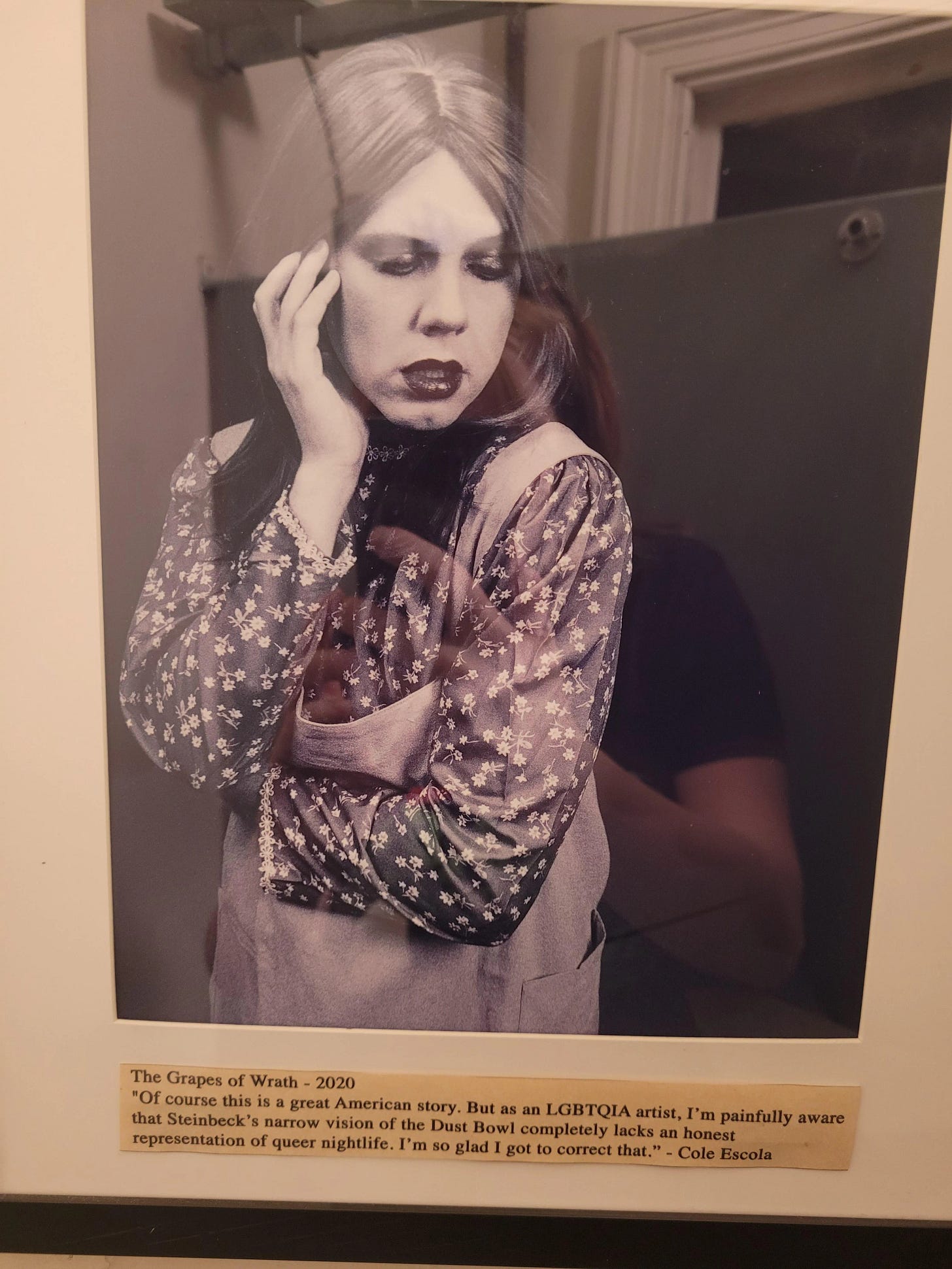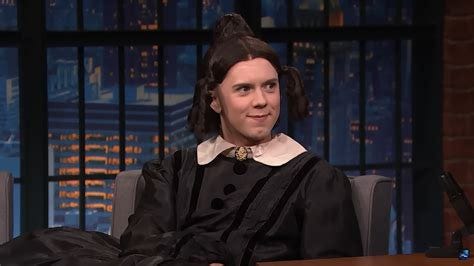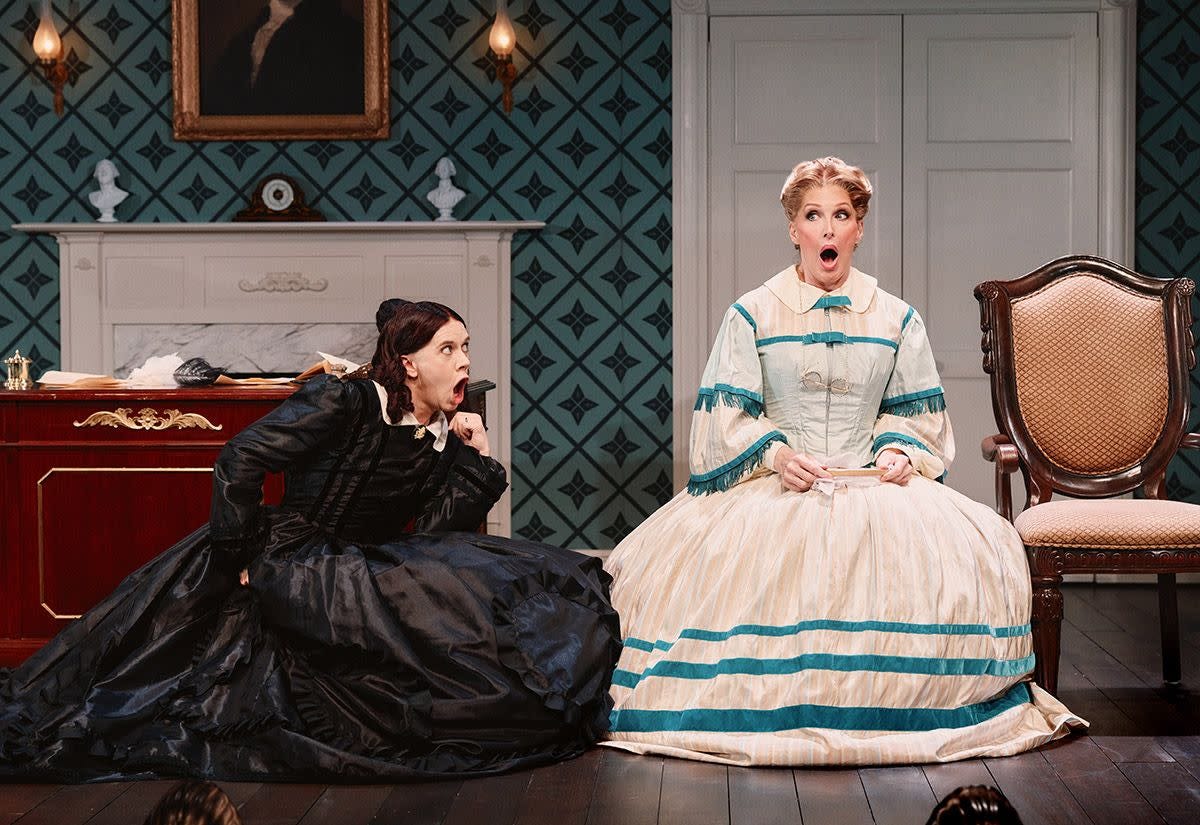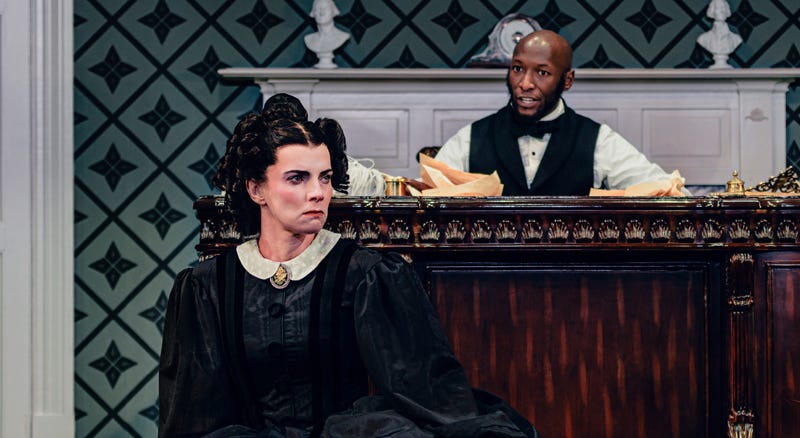"Being rigorous about being stupid": Behind the scenes with the creative team of Oh, Mary
At BroadwayCon2025, the Oh, Mary creative team shared stories and insights about making the hit comedy.
The creative team* of Oh, Mary with Broadway News’ Ruthie Fierberg (right).
This article contains Oh, Mary spoilers.
The first time I saw Oh, Mary, Cole Escola’s brilliant farce about Mary Todd Lincoln, I was obsessed with a detail that to this day I have not seen reported anywhere. When you walked into the Lucille Lortel Theatre in the West Village, you were greeted in the lobby and on the stairs by black and white photographs of different shows. This is a standard feature in theaters, and as a result many walk by without even stopping to look.
But if you did stop, you discovered that rather than displaying a series of past shows at the Lortel, the photographs were all of Escola playing different ridiculous roles. Here they are as Cassie in A Chorus Line—on crutches.
Here they are doing Night, Mother… with a puppet.
Here they are “correcting” the Grapes of Wrath.
(I grabbed these shots from a Reddit about the photos. You can find many more there.)
As I read the caption of each photo with delight, I remember thinking not only how hilarious they were, but what a fascinating choice they represented in terms of creating a world. Before you sat down, you were being taught how to think about Escola and this show. You were being told you were in a different universe.
This weekend at the BroadwayCon panel with the designers and director of Oh, Mary led by Ruthie Fierberg, EIC of Broadway News, a number of the designers talked about the ways in which Escola helped them enter into the concept of this world. Said Holly Pierson, costume designer on Oh, Mary, Escola told her, “Imagine you’re at a regional theater and you’re playing a costume designer who is designing a play.”
Escola’s script also came with little drawings by Escola. “They looked like your school play,” said director Sam Pinkleton, “Like when your high school did Arsenic & Old Lace.” The point, as co-scenic designer Andrew Moerdyk pointed out, wasn’t to recreate those sketches on stage. Pinkleton agreed: The drawings were rather a “really good clue for the team” as to the tone of this world.
Many on the panel spoke about the specificity of Escola’s vision for the piece, and how useful that was. Finding the right wigs for Mary and the others took months, said wig designer Leah J. Loukas. But the clarity of Escola’s vision was at the heart of that search: “It’s kind of like when you live an apartment, you kind of have to live there a while before you know where the bedroom should be, you know?”
Cole Escola as Mary Todd Lincoln.
Pinkleton noted, Escola’s gift was creating strong boundaries: “I think Cole came with a really strong sense of what it isn’t,” he explained, “and a really strong sense of the spirit of it.”
Over the course of the hour-long conversation, Fierberg went deep into every aspect of the design of the show, which made for fascinating conversation. Asked about the hilarious sudden blackouts between scenes, which Fierberg compared to a high school play, lighting designer Cha See said Disneyland was the reference point: “When we were in rehearsals,” See explained, “we were all talking about ‘You know as a kid it’s going to be your first ride of your life, and it’s like Epcot?’” For her Mary’s odd, awkward blackouts were inspired by that experience.
Talking about See’s lighting choices also provided one of many fascinating windows into the way that the design team thought about the comedy of Oh, Mary. As with the wigs and every other department, there was the trial and error of finding the funniest choice. When it came to the blackouts, See said they tried something slower and it didn’t work as well. “The slowness of it takes the air out of it,” Fierberg agreed. “It’s the bluntness that gives it the [comedy].”
“I think in every department as we were working, we learned a little bit about commitment,” said Pinkleton. “There’s just nothing worse to me than a medium choice. It’s like, Do it one, or do it ten.” So on the lighting Pinkleton recalled asking See in rehearsal, “Can this look more like Princess Cruise Lines?”
But at times the designers discovered that finding the comedy could also mean just getting out of the way and letting Escola do their thing. Asked “What makes funny set design,” Moerdyk, who co-designed the set with the rest of the dots collective members Santiago Orjuela-Laverde and Kimie Nishikawa, said, “It was such an interesting process. It’s really a process of trying to not be funny.” Moerdyk recalled a big idea they had for the Ford Theater—“We were trying to be really clever with it.” And it proved unnecessary. “Let the comedy of the language be the thing that’s funny,” they realized.
Cole Escola as Mary Todd Lincoln and Conrad Ricamora as Mary’s Husband.
“My memory of the process,” Pinkleton noted, “does not include many sentences that began with, ‘Wouldn’t it be funny if….’ Because nothing will ever be funnier than the play and Cole’s performance. So it’s like you said: Let it do its job.”
Again and again, the idea the designers referred back to was, in Moerdyk’s words, “being rigorous about being stupid.” The comedy came not from aiming for the yuck yuck, but digging into the world as deeply as they could. “Yes, indeed, the books on the shelf are painted and spell out the alphabet,” said Pinkleton. “But somebody really tried to make them look like books. And I feel like that is in every department.”
So, too, the costume ideas, like the colors of Mary’s Chaperone’s dress, emerged out of period research—”At that time there was a lot of clashing, almost garish color use,” said Pierson. Her vision was that she should look like “a cupcake, like a meringue.”
Cole Escola as Mary Todd Lincoln and Bianca Leigh as Mary’s Chaperone.
The wacky idea of the Oval Office having big double doors also came from looking at theater of the time. Because of the enormous size of the women’s dresses, Moerdyk and Orjuela-Laverde explained, 1860s theater regularly had double doors on stage.
When it came to the hair, to reproduce the time’s wigs of horse or goat hair, Loukas used synthetic material. But it turns out a synthetic wig of a uniform color actually does not look like that color under the light. “With synthetic the lighting reacts differently than it does with human hair because of the way it absorbs light,” she explained. “The more colors that look ridiculous together up close actually work the best.” And so for Mary Loukas had to design a wig from five different colors of synthetic hair.
“We had a shared love of rigorous theater making and dumb gay stuff, which are really the same thing,” said Moerdyk. Pinkleton agreed: “Maybe an initial choice was funny, or stupid, or from your high school or whatever,” summarized Pinkleton, “but the joy of it was in taking that really seriously.”
The show has continued on without Escola, now with Betty Gilpin, stand-by Hannah Solow, and soon Titus Burgess. And Pinkleton says it’s been eye-opening to see their different interpretations. “Having new people has actually taught me what a good play Cole wrote,” Pinkleton explained, and the “sturdiness” of the team’s production. “I hope in 10 years I’m seeing my mother-in-law in it in a community theater in Indiana.”
“I texted Cole the other day at 3 o’clock in the morning the other day, which is when we talk,” Pinkleton revealed. “And I said, I think I learned what we made.”
Betty Gilpin as Mary Tood Lincoln and Phillip James Brannon as Mary’s Husband.
*The Oh, Mary creative team: Holly Pierson (costumes), Leah J. Loukas (wigs), Cha See (lighting), Santiago Orjuela-Laverde and Andrew Moerdyk (scenic design), Sam Pinkleton (director).












Cole as Cassie will always be my favorite photo!